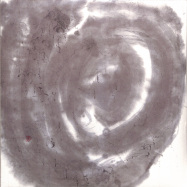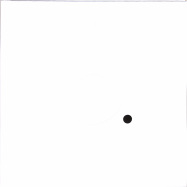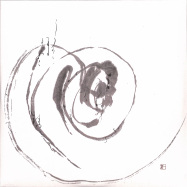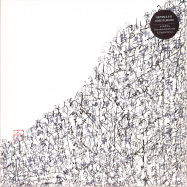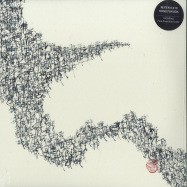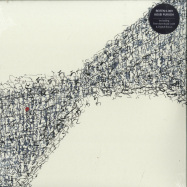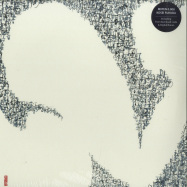
e-mail reminder
If this item in stock, then you will get an infomation E-Mail!Ruten is the first part of two 2LP albums
After two series of conceptual EPs and the intricate experimental “Enso” Festival compilation, Kosei Fukuda returns with a full length solo project – the debut LP. This marks his thirteenth release on the Reiten label – a platform he created to showcase his techno music and the more general, experimental aesthetic agenda of which the club music is but one facet. As a producer and sound artist, Fukuda has shared his time between Tokyo and Berlin. Delving into the music scene of the latter in the late 2010s, he attracted attention of Berghain resident Tobias Freund who mixed all Reiten releases from the third one on in his Non Standard Studios and contributed a remix on the fifth. Soon another remix package followed, with the works by Uchi and Claudio reinterpreting the single “Sky Clair” which in turn paved the way for four subsequent techno twelves and an accomplished ambient EP. Released in a quick succession, they jointly formed a minimalistic narrative arc punctuated by suggestive titles and integrated by dark atmospheres. That series was a proof of Fukuda’s penchant for longer, conceptually inclined works which culminated in early 2020 in the two-vinyl collection of electro-acoustic improvisations under the philosophical aegis of Enso featuring such acts as Recent Arts, Renick Bell or Rabih Beaini.
It is only logical then that having cut twelve records of such scope, the artist’s energy has now been channeled toward making one coherent authorial statement capable of bringing all the strands of his musical and theoretical outlook together, while also distilling a new vision that transcends the confines of the dancefloor. It comes in the form of the generous double album entitled ‘Ruten’ – a Japanese concept whose closest Western counterpart is the ancient Greek notion of ‘panta rhei’. Referencing Heraclitus’ famous adage that ‘everything flows’ is not just the philosophical inspiration behind the album but also the succinct aesthetic manifesto of sorts. Music is a perfect medium here because, like all events, it unfolds in time. And it’s a process whose meaning can only be perceived in its entirety. In this sense the full length release perfectly facilitates the task of expressing this insight and reinterpreting it for a new generation of listeners.
In principle, the two albums called Ruten – and Ruten + are meant to represent the principle of Ying & Yang, the two elemental forces and the eternal cycle of energy. As a whole, they signify a journey from the nascent being to the eventual dissolution of everything into nothing. Yet there’s still a deeper message at play: the omnipresence of patterns. Even the incessant flow of changes is patterned. The philosphers ask what it tells us about reality. The artists offer answers, each coded in the respective artistic language. In this work Fukuda hints at an idea that a pattern is both an abstract structural quality and a concrete aesthetic value. The music contained here is a complex sonic story about the interlocking meanings of pattern and flow, and it is a meditative exploration of the human experience of this entwinement. The first volume starts appropriately with the unassuming intro “dawn” and proceeds from the investigative look at the evanescent yet tangible droplets of “mist” and on to the contemplative gaze at the most distant, unreachable constellation of “nebula”. Regardless of metaphorical intent though, the music moves within one universe of downtempo, ambient and drone, combining the palpable beats (rhythmic pattern) with the atmospheric backgrounds (harmonic flow).
As is the case with all Reiten label releases, the carefully designed sonic textures and moods take precedence over traditional melodic lines. But make no mistake – this is not a self-indulgent ‘free’ experimentalism. Rather, it’s a progression of loose but recognizable sonic shapes or figures, from small scale to large scale, whereby each track appears to be a symbolic closeup study of one. If this music feels like it has a veritable cinematographic quality to it, then it could be described as a soundtrack to slow-motion razor-sharp images of natural flows: picture, for instance, an intermittent light summer rain (“samidare”) or the majestic stretch of the Milky Way against the vast, pitch black backdrop (“tenkan”).
The second volume offers a different take on such explorations, moving towards more nebulous and more fuzzy modes of musical imagination. It is here where Fukuda’s music begins to evince ineffable qualities, going beyond words that could definitively grasp its content. As such it seems to be asking: are patterns really there, or are we projecting them onto the world? This change of the composition style signifies a change of intellectual perspective, the second complementing the first. Drone-like sounds of the opening tracks appear alien initially, but on closer inspection they are reminiscent of this-wordly ambient sounds – just amplified many times over, stretched to a border of recognition, and rearranged for a thought-provoking auditory experience. They are impressionist vignettes where chromatic properties count for much more than any beat or harmonic structure.
As you delve deeper into the record, the tracks are more like imaginary, fully abstract worlds, departing from any recognizable natural inspirations and expanding into the wholly ARTificial eerie creation. If Volume One played with fragments and vestiges of melodic elements, Volume Two appears to aim at submerging the listener into dissipative sonic structures: there are few traditional musical figures to speak of – instead, a series of electronic sheats of sound reign, and the shapes have been largely turned into the dust of sonic particles, decomposed and scaterred as exemplified by “kongen”, “konton” and “hougen”. Beats return only occasionally, for instance on “reigen”, and they perpetuate the abstactness of music rather than dispel it.
As a rule, here most individual tracks conjur up sheer electro-acoustic spaces that can accommodate various kinds of interpretations and suggest a whole range of emotions at once: from uncomfortable menace to contemplative repose to indifference of a post-human synthetic world. By the time you reach the last vinyl side which starts with “shouryou”, any crisp textures or rhythmic throbs and drones seem gone forever, as if to imply that the cosmic flow always proceeds from the primordial chaos on to the emergence of graspable bits and then again to the elusive cloud-like entities and the eventual dissolution. Yet the last two tracks – “youen” and “ruten” – offer somewhat different and unanticipated glimpses into more classically defined ambient soundscapes. While the former of the two is an expansive mournful one, the latter acts as the concise coda based on sparse yet clear-cut chord structure. It is therefore the entirety of this double album, not just its individual elements and segments, that reveal the full intention of the artist. It demands sustained attention but it also rewards it in more than one way.
Dominik Bartmanski
Berlin, October 2020
Customers who bought this item also bought :
more releases on label
more releases by artist
* All prices are including 0% VAT excl. shipping costs.
